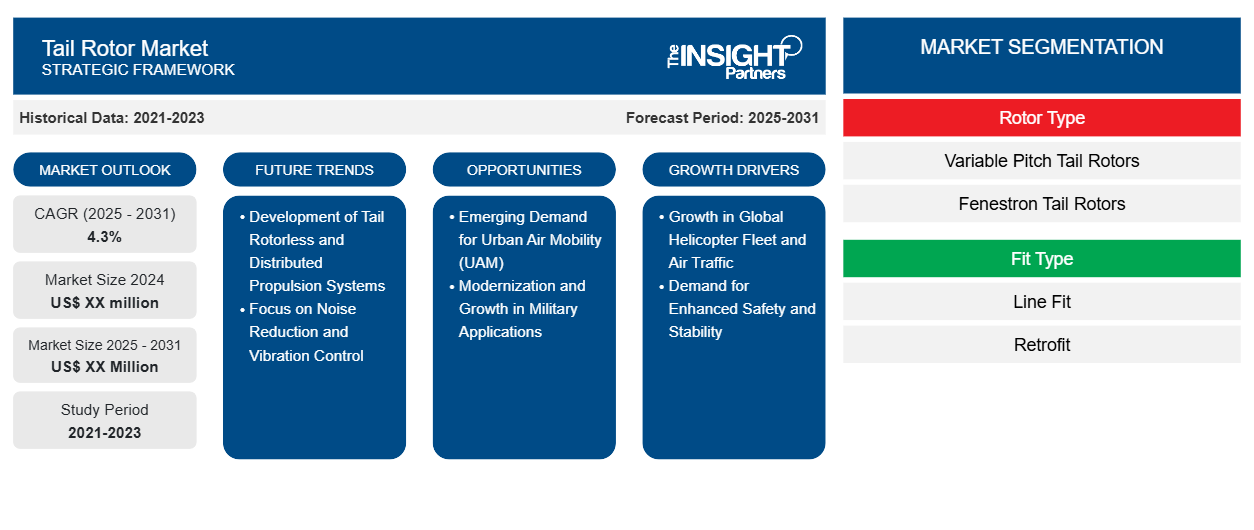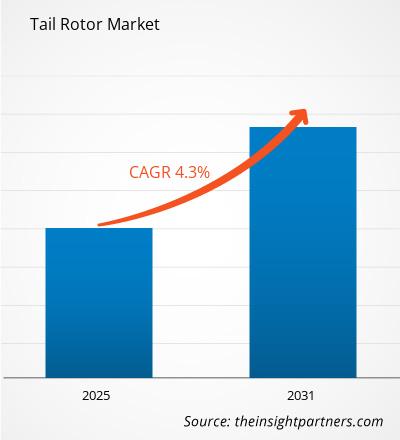The Tail Rotor Market is expected to register a CAGR of 4.3% from 2025 to 2031, with a market size expanding from US$ XX million in 2024 to US$ XX Million by 2031.
The report is segmented by Rotor Type (Variable Pitch Tail Rotors, Fenestron Tail Rotors); Fit Type (Line Fit, Retrofit); Application (Civil/Commercial Helicopter, Military Helicopter). The global analysis is further broken-down at regional level and major countries. The Report Offers the Value in USD for the above analysis and segments.
Purpose of the Report
The report Tail Rotor Market by The Insight Partners aims to describe the present landscape and future growth, top driving factors, challenges, and opportunities. This will provide insights to various business stakeholders, such as:
- Technology Providers/Manufacturers: To understand the evolving market dynamics and know the potential growth opportunities, enabling them to make informed strategic decisions.
- Investors: To conduct a comprehensive trend analysis regarding the market growth rate, market financial projections, and opportunities that exist across the value chain.
- Regulatory bodies: To regulate policies and police activities in the market with the aim of minimizing abuse, preserving investor trust and confidence, and upholding the integrity and stability of the market.
Tail Rotor Market Segmentation
Rotor Type
- Variable Pitch Tail Rotors
- Fenestron Tail Rotors
Fit Type
- Line Fit
- Retrofit
Application
- Civil/Commercial Helicopter
- Military Helicopter
Geography
- North America
- Europe
- Asia-Pacific
- South and Central America
- Middle East and Africa
You will get customization on any report - free of charge - including parts of this report, or country-level analysis, Excel Data pack, as well as avail great offers and discounts for start-ups & universities
Tail Rotor Market: Strategic Insights

-
Get Top Key Market Trends of this report.This FREE sample will include data analysis, ranging from market trends to estimates and forecasts.
Tail Rotor Market Growth Drivers
- Growth in Global Helicopter Fleet and Air Traffic: The increasing demand for helicopters in both civilian and military sectors is a major driver of the tail rotor market. Helicopters are widely used in commercial aviation, emergency medical services (EMS), law enforcement, military applications, and various other sectors. The growth of these applications, along with the expansion of the global helicopter fleet, directly boosts the need for tail rotors. With rising air traffic and increasing demand for air mobility solutions, especially in densely populated regions and in emerging markets, the tail rotor market is expected to see significant growth.
- Demand for Enhanced Safety and Stability: The primary function of a tail rotor is to maintain stability and control during flight. As helicopter operations become more complex and safety standards become stricter, the demand for more reliable and robust tail rotors has increased. This is especially true for military helicopters used in combat and high-risk operations, where tail rotors are critical for maneuverability, precision control, and overall flight safety. The emphasis on improving aerodynamic efficiency, reducing the risk of mechanical failure, and ensuring consistent performance in all flight conditions is a major driver in the development and production of high-quality tail rotors.
Tail Rotor Market Future Trends
- Development of Tail Rotorless and Distributed Propulsion Systems: Another significant trend is the development of tail rotorless or distributed propulsion systems, especially in the context of eVTOL and UAM aircraft. Some new rotorcraft designs are looking at replacing the traditional tail rotor with distributed electric propulsion systems that use multiple smaller rotors for thrust and stability. While these systems are still in the developmental stage for many vehicles, they represent a shift in the industry toward more integrated, efficient propulsion systems that eliminate the need for a separate tail rotor. The move towards distributed electric propulsion systems is expected to influence the tail rotor market as aircraft designs evolve. However, it also presents a challenge for traditional tail rotor manufacturers, who must adapt to the changes in propulsion technologies.
- Focus on Noise Reduction and Vibration Control: Noise reduction and vibration control are critical trends in the tail rotor market. Helicopters generate significant noise during flight, which is an important concern for both military and civilian operators, especially in urban areas or near sensitive zones. To meet these challenges, the industry is focusing on quieter tail rotors that produce less acoustic disturbance. Manufacturers are developing sound-dampening technologies and advanced rotor blade designs that help minimize noise. Additionally, the integration of active vibration control systems is enhancing the stability of the tail rotor and reducing wear, contributing to smoother, more reliable operations. The demand for quieter, more efficient tail rotors is expected to grow, especially as environmental concerns and regulatory pressure to reduce noise levels increase.
Tail Rotor Market Opportunities
- Emerging Demand for Urban Air Mobility (UAM): The growing interest in urban air mobility (UAM) and eVTOL (electric vertical takeoff and landing) aircraft presents significant opportunities for the tail rotor market. As cities move toward adopting air taxis and short-range urban transportation systems, the design and integration of tail rotors will play a critical role in ensuring stability and control for these new types of aircraft. While many electric aircraft designs aim to eliminate the need for traditional tail rotors by using distributed electric propulsion systems, there is still potential for innovations in tail rotor technologies for hybrid or conventional rotorcraft used in urban environments. This emerging sector presents a new opportunity for companies in the tail rotor market to explore alternative propulsion and stabilization technologies.
- Modernization and Growth in Military Applications: The military helicopter market continues to expand, driven by defense modernization programs, counterinsurgency operations, and the growing demand for advanced rotorcraft with superior agility and stability. Military helicopters require high-performance tail rotors that can handle extreme conditions, including combat, rescue missions, and transport. As countries modernize their defense capabilities, the demand for advanced tail rotors that offer better control, reduced noise, and improved performance is growing. Manufacturers can capitalize on this demand by providing specialized tail rotors tailored for military rotorcraft, such as attack helicopters, transport helicopters, and search and rescue helicopters.
Tail Rotor Market Regional Insights
The regional trends and factors influencing the Tail Rotor Market throughout the forecast period have been thoroughly explained by the analysts at The Insight Partners. This section also discusses Tail Rotor Market segments and geography across North America, Europe, Asia Pacific, Middle East and Africa, and South and Central America.
Tail Rotor Market Report Scope
| Report Attribute | Details |
|---|---|
| Market size in 2024 | US$ XX million |
| Market Size by 2031 | US$ XX Million |
| Global CAGR (2025 - 2031) | 4.3% |
| Historical Data | 2021-2023 |
| Forecast period | 2025-2031 |
| Segments Covered |
By Rotor Type
|
| Regions and Countries Covered |
North America
|
| Market leaders and key company profiles |
|
Tail Rotor Market Players Density: Understanding Its Impact on Business Dynamics
The Tail Rotor Market is growing rapidly, driven by increasing end-user demand due to factors such as evolving consumer preferences, technological advancements, and greater awareness of the product's benefits. As demand rises, businesses are expanding their offerings, innovating to meet consumer needs, and capitalizing on emerging trends, which further fuels market growth.

- Get the Tail Rotor Market top key players overview
Key Selling Points
- Comprehensive Coverage: The report comprehensively covers the analysis of products, services, types, and end users of the Tail Rotor Market, providing a holistic landscape.
- Expert Analysis: The report is compiled based on the in-depth understanding of industry experts and analysts.
- Up-to-date Information: The report assures business relevance due to its coverage of recent information and data trends.
- Customization Options: This report can be customized to cater to specific client requirements and suit the business strategies aptly.
The research report on the Tail Rotor Market can, therefore, help spearhead the trail of decoding and understanding the industry scenario and growth prospects. Although there can be a few valid concerns, the overall benefits of this report tend to outweigh the disadvantages.
Frequently Asked Questions
What are the options available for the customization of this report?
What are the deliverable formats of the tail rotor market report?
What are the future trends of the tail rotor market?
1. Demand for Upgrades and Retrofitting Operations
2.Technological Innovations in Rotor Technologies
What are the driving factors impacting the tail rotor market?
1. Increasing Commercial Helicopters Demand
2. Procurement of Military Helicopters
What is the expected CAGR of the Tail Rotor Market?
- Historical Analysis (2 Years), Base Year, Forecast (7 Years) with CAGR
- PEST and SWOT Analysis
- Market Size Value / Volume - Global, Regional, Country
- Industry and Competitive Landscape
- Excel Dataset
Recent Reports
Testimonials
Reason to Buy
- Informed Decision-Making
- Understanding Market Dynamics
- Competitive Analysis
- Identifying Emerging Markets
- Customer Insights
- Market Forecasts
- Risk Mitigation
- Boosting Operational Efficiency
- Strategic Planning
- Investment Justification
- Tracking Industry Innovations
- Aligning with Regulatory Trends





















 Get Free Sample For
Get Free Sample For